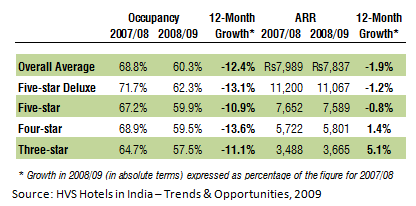The year 2009 has been challenging for the world at large and has rewritten the way in which the nations of the world cooperated in facing the crippling financial crisis together. For the Indian hotel industry, 2009 has been a turbulent and difficult year; hurt by the world's worst-ever economic crisis and the unfortunate terror strike on Mumbai, the industry was brought to a grinding halt, with hotels witnessing the largest occupancy erosion (12.4% year over year) in the last decade. The year 2009 marks an abrupt end to a very robust business cycle, according to trade experts, who also feel it is a timely shake-up for an industry that has seen an unprecedented - and unsustainable - growth in average room rates (ARRs) on the back of a supply-demand imbalance in all major markets across India. No one, however, visualised the magnitude of the crisis. This article seeks to 'look back' at the year gone by.
With the global economic machinery almost stuttering to a halt, the corporate world was engaged in cost cutting via drastic cutbacks on non-essential expenses. The resultant drop in corporate travel, coupled with the travel advisories issued following the November 2008 terror attacks, led to an adverse effect on the industry's performance. The start of the year saw hotel occupancies plummet across the country; room rates, however, did not follow suit, bringing about rate rationalization in the later months. The sharp drop in occupancy in the financial year 2008/09 (Apr-Mar) was a result of the weak winter months. Higher-category hotels witnessed the maximum occupancy erosion, with marginal rate corrections. New supply in the lower-category hotels was essentially responsible for this decline, as customers (with their budgets curtailed in view of the economic situation) were able to find quality options at more affordable prices.

The summer of 2009 saw hotels give precedence to occupancy over rate; rates across star categories in all major markets in the country witnessed year over year corrections in the range of 20-30%. With demand having shrunk, hotels started competing aggressively to capture more business and lure back their old loyalists, who had shifted to lower-category hotels because of the sharp rise in ARRs in the previous few years. At the same time, reservation lead times had diminished considerably and were severely impacting room inventory management. This period also saw the Indian government launch the “Visit India” campaign, which did generate a renewed interest in Indian tourism, a testament to which were the marked improvements in foreign-tourist arrivals in the first quarter of 2009/10 (increase of 2% year over year).
To cope with the downturn in demand, the industry put a freeze on hiring and focused on retention of talent and internal training. Top line erosions resulted in hotels implementing innovative ways to capture demand, lower operating costs, and defer maintenance, renovation and expansion activities. The prevailing market conditions also forced new hotel projects on the backfoot, with many hotel projects being shelved and ongoing developments put on hold owing to financing issues. The Reserve of Bank of India's recent ruling classifying loans for hotel projects outside the purview of bank's commercial real estate (CRE) will provide some respite to the industry. Additionally, with the entry of a few hospitality focused PE funds, certain hotel projects have managed to secure the required funding; moreover, much activity has also been witnessed in distress asset transactions by PE funds.
A year after the collapse of Lehman Brothers, the Indian hotel industry is showing signs of gradual recovery. The credit for this can be largely given to the domestic traveler, who has time and again aided in the hotel industry's recovery and accounts for the bulk of the industry's revenue. With increased spending power and better access to air and road infrastructure this segment is sustaining the leisure and commercial demand in India. Sporting events like the T20 champion's trophy, the upcoming Commonwealth Games in the national capital and development of the airports at Bangalore, Hyderabad, Delhi and Mumbai are enabling the recovery of the Indian hotel industry. Thus, it will only be apt to say that from managing the crisis we are moving towards managing the recovery...
HVS is a fully integrated global consulting and services firm focused exclusively on the hospitality industry and providing a wide range of services to owners, lenders and operators throughout the world. In India, HVS offers hospitality consulting, valuations, investor search, management contract negotiations, asset management and strategic operational advisory services. Our HVS Executive Search division is strong in hotel, real estate, retail, medical and energy infrastructure sectors. For more information, please contact Manav Thadani, MD on [email protected] or visit www.hvs.com. The author for this issue is Tapan Srivastava, Associate with HVS Delhi.

Dear Tapan, I basically agree with you however it is worth noting that the Indian Hotel industry for the last few years prior to the wold economic turmoil has certainly stained the reputation in overcharging business and leisure travellers without offering the appropriate value/price, quality/product intrinsicly and extrinsicly and the likes. therefore the setback is partly due to the operators and owners greed. I only hope that this lesson serves to reajust the Indian Hospitality organizational landscape for better formulating the future offering framework Many thanks and best wishes.